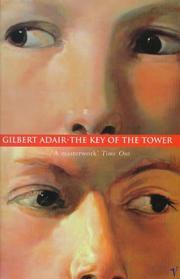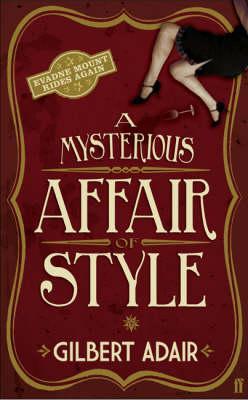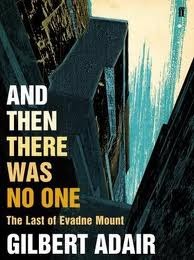Regular readers of this site are no doubt sick of the mention of Gilbert Adair, given that he’s the most reviewed writer here and I’ve already reviewed the brilliant The Death Of The Author this month. Bear with me, though, for there’s not much of his fiction to go before I can begin to pester with another obsession.
The thing with Adair is that there’s no real consistency to his books. After enjoying the postmodern murder mystery of The Act Of Roger Murgatroyd, he followed it with the lesser A Mysterious Affair Of Style; similarly the high of The Death Of The Author was followed by The Key Of The Tower (1997), arguably the weakest in his ouevre.
Dud or not, reading Adair’s prose is always a delight, purely for the unashamed fun he has with wordplay and subverting expectations. Reading him is always like sitting down to listen to an old friend that you don’t quite trust.
Where other Adair novels wear their literary influences on their sleeve, the obvious comparison for The Key To The Tower is not to be found in books, but movies. Hitchcock’, especially. From the off Adair sets up a scene that wouldn’t be out of place in one of Hitch’s features: two cars on a road in Brittany, both halted by a fallen tree. One of the drivers is Guy Lantern, on holiday from England in his second-hand Mini; the other, in his Rolls-Royce, is Jean-Marc Cheret, a wealthy art dealer. On deciding that the only logical choice is to swap cars and drive off to their intended destinations, meeting up three days hence, they exchange car keys and the story begins.
Cheret disappears from the picture for the novel is narrated by Guy Lantern, the man in the Mini. Continuing on, he reaches where he was headed: the small town of Saint-Malo. After a comedy of errors, Lantern meets Cheret’s wife, Béa.
Am I, I couldn’t resist putting to myself, am I going to fall in love with her? What a fantasy! It was absurd and puerile and yet…and yet, apart from the unique set of circumstances of our meeting, the romantically corny lightning flash (fate’s patented trademark, its tired old logo) and the swapping of cars, my excuse, my sole excuse, for thinking such a thought was the fact, the indisputable fact, that we all of us lead a double life. No one can monitor our loves and lusts. No one can set police dogs sniffing around the insides of our brains. Sexual attraction is what cosmologists term a singularity. It’s the black hole of the psyche, where the priorities of the realist imperative no longer apply. In my head at least, I told myself, I could do as I pleased.
Ah, the priorities of the realist imperative need no longer apply. It’s a fitting line to throw into the narrative, as it carries a second meaning – it refers to the narrative itself, because from this point onward, what had been a suspenseful and psychological thriller, à la Hitchcock, descends into a whimsical catalogue of unbelievable events, actions, and dialogue.
The basic premise centres around Lantern becoming innocently embroiled in an illicit art trade. It’s pure parody, with knowing winks aplenty, and a range of characters so over the top – like a gangster who uses Proust’s À la recherche du temps perdu as his Bible – as to undermine the initial seriousness of the book: the suspense is wrung out, the characters lose dimensions as the pages turn. Even the way in which Lantern learns of the crime he’s involved is done in that clichéd style where the criminal delights in having their misplaced genius accounted for:
Béa nodded – and again, I had the feeling that she was willing me on, wanting me to know that I was getting warm, nodding only in acknowledgement of what I had already found out but as if encouraging me on to ever further revelations, drawing each new fragment of truth out of me as, clue by clue, some general-knowledge staple – please sir, 1066 – may be drawn out of a schoolchild.
In all, The Key Of The Tower is a book of halves, strictly divided by the fall of a tree, be they plot points or the structure itself. While the notion of Adair doing Hitchcock is novel, his drive to parody the genre comes off wanting, and I have no doubt that if he’d stuck to maintaining the atmosphere and suspense then a better novel may have appeared. It now seems, however, that when Adair touches on Hitch (Alistair Farjeon in A Mysterious Affair Of Style is pretty much him in all but name) it may just be best to avoid.
But, damn him, there’s no way you can avoid him because, at his best or not, he’s just so readable as to almost forgive him. At the start of the novel there’s a long description of the Mini’s windscreen wipers, with the occasional snatch of the road ahead. While it primarily relates to Lantern’s journey through Brittany, it’s also reads as a clever portent for the reader.
And at those brief moments when the windscreen had been wiped clear, and before a brand new rash of raindrops erupted, it would come as a slight but real surprise, it would even obscurely disappoint me, that the scenery hadn’t meanwhile been shifted and that the dark mute road in front of me remained unaltered, with only an occasional signpost, preternaturally aglow in the gloom, to attest that I had made any headway.
Come the end of The Key Of The Tower, having barely had the rug pulled out from under itself, the scenery hasn’t shifted, the road is unaltered, and aside from a nod here and there, there’s little to recommend it. He’s right, though, that does come as a surprise.




All I can say about this one is that it has stayed with me least of all the Adair novels, and as you know, I’m the other person in the world (along with you!) who has read most of his books. Oddly enough, the only thing I did remember about it was the scene with the windscreen wipers… And it must be almost ten years since I read it. Weird.
Yes, it’s easy to see why this one has fallen out of print. Not so The Death Of The Author. I suppose, for Adair, Faber Finds looks a likely home…one day.